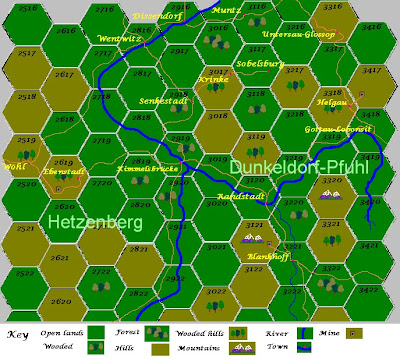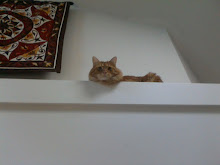 I've begun painting the first regiment of the Margrave's army. This is composed of Spencer Smith 30mm figures in the fine old-school tradition. To begin with I had to feel my way through the painting process with these, as the (deliberate) lack of clear definition (and my aging eyes) makes it hard to place paint in the proper locations. Even so, once I got into the swing of things I found they are nice and easy to paint, and I hope to finish them by this weekend.
I've begun painting the first regiment of the Margrave's army. This is composed of Spencer Smith 30mm figures in the fine old-school tradition. To begin with I had to feel my way through the painting process with these, as the (deliberate) lack of clear definition (and my aging eyes) makes it hard to place paint in the proper locations. Even so, once I got into the swing of things I found they are nice and easy to paint, and I hope to finish them by this weekend. Tuesday, 29 January 2008
Spencer Smith 4.
 I've begun painting the first regiment of the Margrave's army. This is composed of Spencer Smith 30mm figures in the fine old-school tradition. To begin with I had to feel my way through the painting process with these, as the (deliberate) lack of clear definition (and my aging eyes) makes it hard to place paint in the proper locations. Even so, once I got into the swing of things I found they are nice and easy to paint, and I hope to finish them by this weekend.
I've begun painting the first regiment of the Margrave's army. This is composed of Spencer Smith 30mm figures in the fine old-school tradition. To begin with I had to feel my way through the painting process with these, as the (deliberate) lack of clear definition (and my aging eyes) makes it hard to place paint in the proper locations. Even so, once I got into the swing of things I found they are nice and easy to paint, and I hope to finish them by this weekend. Sunday, 27 January 2008
Mapping - the Cockpit.
 Here's a small part of the campaign map for the wars between the Grand Duchy of Hetzenberg and the Margravate of Dunkeldorf-Pfühl. The major (as yet unnamed) river forms the main border between the two, and flows south-to-north. The extract shows "the Cockpit," a broad valley centered around the town of Kimmelsbrücke which has an important fortified bridge. The uplands to the west of the town are rich in mineral resources, and a silver mine is shown near the town of Ebenstadt.
Here's a small part of the campaign map for the wars between the Grand Duchy of Hetzenberg and the Margravate of Dunkeldorf-Pfühl. The major (as yet unnamed) river forms the main border between the two, and flows south-to-north. The extract shows "the Cockpit," a broad valley centered around the town of Kimmelsbrücke which has an important fortified bridge. The uplands to the west of the town are rich in mineral resources, and a silver mine is shown near the town of Ebenstadt. *
Coal, iron and silver - three minerals which have plenty of applications for warfare - and a broad valley just right for military maneuvers. With tensions rising between the two nations, the valley of the Cockpit may soon be living up to its name...
Wednesday, 23 January 2008
Mapping - 1.
Saturday, 19 January 2008
Progress report - 14.
Tuesday, 15 January 2008
Spencer Smith 3.
Saturday, 12 January 2008
Assemblage of troops.
 Infantry Regiments #1 Sleibnitz and #2 von Wöhl, led by the Leibgarde Grenadiers, on their first maneuvers of the New Year, with the Blaueberge in the background.
Infantry Regiments #1 Sleibnitz and #2 von Wöhl, led by the Leibgarde Grenadiers, on their first maneuvers of the New Year, with the Blaueberge in the background.  The Bishop of Guggenheim's Regiment of Horse on maneuvers.
The Bishop of Guggenheim's Regiment of Horse on maneuvers. Thursday, 10 January 2008
Hirst Arts.
Tuesday, 8 January 2008
The Bishop of Guggenheim's Regiment of Horse - 3
Saturday, 5 January 2008
Militia matters.

*
The uniform shown above is for the City & District of Guggenheim, a prosperous community well able to provide its militia with uniforms. Parochial and guild pride has led to liberties being taken with the uniform colors though, with different parishes and guilds fielding companies in distinct variations. In the case of the company on the right, some enterprising fellow has even contrived to obtain breeches in the Prussian blue favored by IR 1 Sleibnitz of the regular army. The common theme to them all is the weskit, cuffs, turnbacks and cockade in the Guggenheim colors.
*
There is no set pattern for militia standards, although the Hetzenberg Cross of St. Ungulant always appears somewhere in the design. Much as in the American Civil War days, such standards are created and presented at special parades by various groups of patriotic citizens to their local militia company.
Wednesday, 2 January 2008
How do you solve a problem like militia?
1,500 Visits.
Tuesday, 1 January 2008
The Tower Project - 4 - In color.
 The side of the tower.
The side of the tower. 





